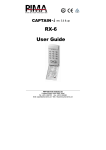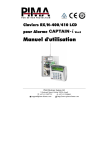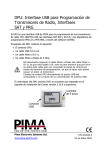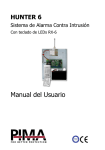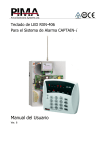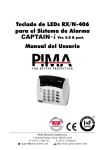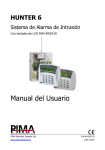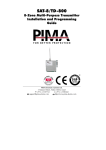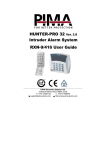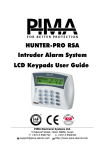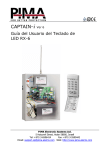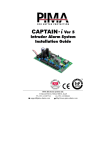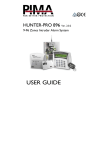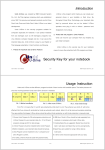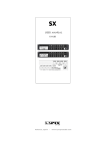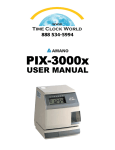Download User Guide - Pima Electronic Systems Ltd
Transcript
CAPTAIN 6 6 Zones Intruder Alarm System USER GUIDE System ver. 6.0 PIMA Electronic Systems Ltd. www.pima-alarms.com P/N 4410049, G2 XX en, Jan. 2010 CAPTAIN 6 User Guide 2 SAFETY INSTRUCTIONS Your CAPTAIN-i alarm system has been registered in accordance with EN60950 and its rules. EN 60950 requires us to advise you the following information: 1. In this alarm system exists hazards of fire and electric shock. To reduce the risk of fire or electric shock, do not expose this alarm system to rain or moisture. Pay attention: Telephone cords could be a good conductor for lightings energy. 2. Do not open the door of the alarm system. Dangerous high voltages are present inside of the enclosure. Refer servicing to qualified personnel only. 3. This alarm system should be used with AC 230V50Hz, protected by anti electric shock breaker. To prevent electric shocks and fire hazards, do NOT use any other power source. 4. Do not spill liquid of any kind onto the unit. If liquid is accidentally spilled onto the unit, immediately consult a qualified service. 5. Install this product in a protected location where no one can trip over any line or power cord. Protect cords from damage or abrasion. 6. Disconnect all sources of power supply before proceeding with the installation. Pay attention: do not install low voltage wires near by AC power wires they should be separated. 7. Connect the AC transformer output to the terminal block on the control panel as marked. 8. Connect the AC line cord to line power terminals as marked. (GND; N; L) Table of contents Introduction........................................................................................................3 Main Features ........................................................................... 3 Access and Operation Codes........................................................ 4 Keypad Description .................................................................... 5 System Functions................................................................................................6 Green LED and System Status ....................................................10 Programming Functions .............................................................10 Faults Indications .............................................................................................14 General Information .........................................................................................15 Zone Names ............................................................................15 Installer Information .................................................................15 CAPTAIN 6 User Guide 3 INTRODUCTION Congratulations on your purchase of the CAPTAIN-i Alarm System. Much care has been taken in developing the CAPTAIN-i alarm system, which will provide you with unprecedented peace of mind. The CAPTAIN-i user-friendly operation and advanced features will professionally protect your home or business. It is important to familiarize yourself with the CAPTAIN-i Alarm System in order to take full advantage of the complete range of the CAPTAIN-i features. To assure optimum safety and security, you should test the CAPTAIN-i Alarm System once a week. Main Features ♦ 6 programmable zones ♦ Two partitions ♦ Dialer: Up to three preset private telephone numbers and four Monitoring Station numbers ♦ Various modes of arming and disarming: keypad, key, remote control, automatic ♦ Four types of keypads: A simple LED keypad (RX-406 or RX-6), LCD keypads (RXN-400 or RXN-410) and Anti-vandal keypad RX/N-200 ♦ Up to six different keypads, connected in parallel ♦ Two operating modes: Full or Home ♦ System Events is registered in memory (40 non-volatile) ♦ Various operating codes: Master Code, up to eight User Codes, and Short Code ♦ User Code #8 can function as DURESS code ♦ Optional temporary bypass of zones ♦ “Chime” mode per zone: operates the keypad buzzer when a zone is opened (e.g., to monitor a back door when system is disarmed) ♦ Monitoring Station Communicator: built-in dialer (private & CMS), integrated Long-Range Radio and Cellular Transmitters ♦ Inhibit system from arming in case of failure (optional) ♦ Short-keys for DURESS and FIRE codes CAPTAIN 6 User Guide 4 Access and Operation Codes The following codes are used to access and operate the CAPTAIN-i Alarm System: ♦ Master Code: Use this code when programming system parameters. The default factory Master Code is 5555. For security reasons, it is not recommended to use the default code to arm or disarm the system. IMPORTANT! For better protection, the default factory Master Code must be changed. ♦ User Code: 4-6 digit code. Up to eight User Codes can be programmed, User Code 1 to User Code 8. ♦ Short Code: A convenient, two-digit code used only to arm the system. ♦ Duress Code: 4-6 digit code used for disarming the system in case it is armed, and sending duress event to MS, or sends silent duress event to MS in case system is disarmed. PIMA’s LCD keypads RXN-400 and RXN-410 were especially designed for maximum simplicity, durability and decorative design. The keypad is used for arming, disarming and programming the system as well as displaying time and date, system status information, events and defaults, memory log and more. Up to six keypads can be connected to the system CAPTAIN-i. Both keypad models are identical, except for the size of the display screen: RXN-400 Normal screen 15 x 60 mm RXN-410 Large screen 23 x 97 mm Both keypads must be powered by nominal 12VDC (9VDC13.8VDC tolerance) from Limited Power Source power supply. Compliant with Clause 2.5 of EN 60950-1:2006 Standard. CAPTAIN 6 User Guide 5 Keypad Description System Fault Description (see page 14) Zones Status ARM LED (green) Fault LED (red) System Status System Time RXN-410 AC line T 12:40 -A---B Num & Function keys Navigation & Programming keys Display Screen ♦ The upper line displays the System Fault, System Status and Time System Status: P System communicating or testing PSTN line T System reporting to Monitoring Station via radio transmitter ♦ The lower line displays information about the zones’ status. Each of the following characters signifies a certain status. The characters appear above the zone number on the display. - Closed zone _ Opened zone B Bypassed zone A Alarm zone (zone triggering alarm) C Chime zone F Failed zone (disconnected or shorten) CAPTAIN 6 User Guide 6 SYSTEM FUNCTIONS IMPORTANT! The [ symbol indicates information that you must enter. To arm the entire alarm system: [ Any User Code (User Code #1 to #8) that was allocated by the installer to both partitions [ Master Code [ OR OR Short code. To disarm the entire alarm system: [ Any User Code (User Code #1 to #8) that was allocated by the installer to both partitions OR Master Code [ IMPORTANT! Entering the Master Code when one of the partitions is armed will arm the other partition as well. Entering the Master Code when both partitions are armed will disarm the entire system. To arm the alarm system to HOME mode: Press and hold HOME 2 [ Any User Code / OR [ Short code. To disarm the alarm system: [ Any User Code (User Code #1 to (or 7 ) #8) To arm/disarm Partition #1: [ Any User Code that was allocated by the installer to partition #1 (toggle mode) To arm/disarm Partition #2: [ Any User Code that was allocated by the installer to partition #2 (toggle mode) CAPTAIN 6 User Guide 7 NOTE: User can arm/disarm only partitions allocated to him by the installer (partitions #1, #2, or both). All keypads connected to the system share the same display, even if they are allocated to different partitions. IMPORTANT! If the installer enabled the “Failure Inhibits Arming” feature, the user will not be able to arm the system in case of failure (i.e. AC, Battery, etc.) For further information on this feature turn to CAPTAIN-I Ver.5 Installation Manual. To bypass/reactivate alarm zone: [ zone number [ [ Master Code [ . OR [Hold and press until you receive the following screen: 9Enter User Code and receive the following screen 9 Enter zone number to be bypassed and receive Enter Code ------ Zone: the following conformation screen (example): Bypassed zone (in this examplezone 3) 02:29 Time --B--1 2 3 4 5 6 7 8 9 10 11 12 13 14 15 16 ♦ Repeat process in order to bypass different zone(s). ♦ To cancel the bypass and reactivate the zone: repeat the bypass activation process with this zone’s number (toggle operation). IMPORTANT! Every bypassed zone is logged in the system’s memory, including the time and date. NOTE: When Bypass mode is executed, it is effective until you disarm the system. To manually reset the smoke or fire detector: Press and hold for 3 seconds. CAPTAIN 6 User Guide 8 To identify the zone that is the cause of the alarm: The letter A is displayed above any Alarm Zone that was triggered while the system was last armed. To enable the Chime mode: Press and hold message display. CHIME . The ON is displayed for about 3 sec on the LCD NOTES: This mode activates a buzzer in the keypad when a Chime Zone is triggered. This feature can be used to monitor unauthorized entry or exit in the defined zone when the system is not armed. To learn how to program a Chime Zone see “To program/cancel a Chime Zone” on page 13. To disable the Chime mode: Press and hold message display. CHIME . The OFF is displayed for about 3 sec on the LCD To view system events in memory: [ Master Code [ , and then scroll using the or keys [ to exit. OR, to view events scrolled automatically: [Press and hold To temporarily cancel the Entry Delay Time: Press and hold and receive the following message: “DELAY OFF”. Press and hold again: “DELAY ON”. NOTE: When this feature is enabled, it is effective only until the system is disarmed. CAPTAIN 6 User Guide 9 Reporting PANIC Event to CMS/Private Dialer: Press and hold and simultaneously for two seconds. NOTE: You can customize your system's response to keypad's panic event, e.g., report to the Monitoring Station or call your private telephone number or sound the siren. Consult your installer about programming keypad's Panic Response. In addition, if the installer programmed User Code 8 as “Panic Code”, entering user code 8 will: ♦ Report a panic event to CMS (logged in memory as “Panic” with time and date) ♦ Disarm the panel or a single partition, or both partitions Reporting DURESS Event to CMS/Private Dialer: Press and hold and simultaneously until a conformation beep from keypad. NOTE: The event is logged in memory as “Duress” and includes time and date. HOME 2 Reporting FIRE Event to CMS: Press and hold 7 and simultaneously until a conformation beep from keypad. NOTE: The event is logged in memory as “Fire” and includes time and date. To disable a keypad's audible tones: Press and hold simultaneously. and NOTE: When the keypad's Audible Tone feature is disabled, all audible tones and indications, with that keypad, are silenced. CAPTAIN 6 User Guide 10 To enable a keypad's audible tones: Press and hold and simultaneously until you hear a beep. Green LED and System Status The Green-ARMED LED will indicate the system status, as follows: ♦ Blinking: The system is in Entry (before disarming) or Exit (after arming) Delay Time mode. ♦ Steady Light: The system is armed. ♦ In case of partitions, see the table below: Armed Partition/s LCD Screen Display Green LED Partition #1 armed Part1 ON 1 blink every 4 seconds Partition #2 armed Part2 ON 2 blinks every 4 seconds Both partitions armed (entire system) **** ON **** Stays lit constantly Programming Functions IMPORTANT! Before beginning to program the CAPTAIN-i Alarm System, you must first enter the Master Code (the default factory code is 5555). When Select appears on the LCD display, you may proceed with programming your system. To cancel a command: [ X3 [Start the programming procedure from the beginning. [ Initial Master Code [ [ new Master Code (4-6 digits) [ [ . To program a Master Code: [ [ CAPTAIN 6 User Guide To program User Code #1: [ [ 11 [ [ [ new User Code (4-6 digits) [ . To delete User Code #1: [ [ Master Code [ [ Master Code [ [ [ To program User Codes #2 to #8: [ [ [ Master Code [ [ (as many times as the User Code number) [ [new User Code (4-6 digits) [ [ [ . To delete User Code #2 to #8: [ (as many as the User Code number) [ [ g [ . Example: When programming or deleting User Code #6, enter the Master Code, press the [ Master Code [ key, followed by pressing the To program a Short Code: [ BACK [ [ [ key six times. [ Master Code [ [ new Short Code (2 digits) [ . . CAPTAIN 6 User Guide 12 To delete a Short Code: [ [ [ Master Code [ [ [ To program Automatic Arming: Master Code [ BACK . [ (HH:MM 24 hour format) [ To program telephone number(s): . [ Master Code [ [Enter the first telephone number including area code [ [Enter the second telephone number including area code [ [ Enter the third telephone number including area code [ [ . NOTES: You can program up to three telephone numbers into the system memory, which will be called in an emergency or when in Alarm Event. To skip a number (i.e., leave the programmed number or leave it empty), simply press . Press to exit the mode. If the CAPTAIN Alarm System is connected behind a PBX, you must enter the outside line prefix digit and an asterisk before the telephone number. For example: 9*555-5555. When the CAPTAIN Alarm System calls to one of the programmed telephone numbers, a siren tone is heard on the subscriber telephone. For playing a pre-recorded message, a VU-20 unit (optional) is required. Consult your installer for this option. It is also possible to connect the microphone unit MIC-200 CAPTAIN 6 User Guide 13 [ Master Code [ With the telephone number(s) to keep[ and with the To delete telephone number(s): one(s) to delete [ [ . to exit. NOTE: To delete all the telephone numbers, [ Master Code x3 [ [ [ . To set the time and date for the system: [ Master Code [ [current time (HH:MM 24 hours format) [ [current date (YY MM DD format) [ [ . NOTES: It is important to set the correct time and date to ensure proper functioning of your CAPTAIN Alarm System. If NO time is entered, the red Fault LED will blink and a message is displayed. To program/cancel a Chime Zone: [zone number [ CLOCK [ Master Code [ . NOTE: This mode activates a buzzer in the keypad when a Chime Zone is triggered. Chime Zones are indicated by the letter C in the display above the programmed zone number (in "Select" mode). CAPTAIN 6 User Guide 14 FAULTS INDICATIONS Display Description Battery Low battery power Phone No dial tone detected AC line AC power failure Clock Appears after initial power input or after total power reset (AC and battery) 4 Low DC Very low DC supply to the alarm card (PCB) Trouble Detector was shorten or cutoff 2 DC FUSE Detectors power line (+/-) was shorten 2 Communic Failure to communicate with Central Monitoring Station (CMS) 2,5 GSM Unit GSM unit is not identified by system GSM Sgnl Low GSM signal 2,6 GSM SIM SIM card failure 2 GSM Com. GSM communication to CMS failure KEYBOARD NOT CONNECTED A problem with keypad connection to the panel 1 2 3 4 5 6 1 2,3 2 Wait 24 hours, if fault persists, contact the installer. Contact the installer. Check the phone line at the premises. Set the system time and date. Contact the Central Monitoring Station. Check with cellular carrier. 2 2,5 2,5 2 CAPTAIN 6 User Guide 15 GENERAL INFORMATION Zone Names No. Name 1 2 3 4 5 6 Installer Information Company Name Tel. Cell phone Email Note 16 CAPTAIN 6 User Guide PIMA Electronic Systems Ltd. does not represent that its product may not be compromised and/or circumvented, or that the Product will prevent any death, personal and/or bodily injury and/or damage to property resulting from burglary, robbery, fire or otherwise, or that the Product will in all cases provide adequate warning or protection. The User understands that a properly installed and maintained equipment may only reduce the risk of events such as burglary, robbery, and fire without warning, but it is not insurance or a guarantee that such will not occur or that there will be no death, personal damage and/or damage to property as a result. PIMA Electronic Systems Ltd. shall have no liability for any death, personal and/or bodily injury and/or damage to property or other loss whether direct, indirect, incidental, consequential or otherwise, based on a claim that the Product failed to function. Please refer to a separate warranty statement found on PIMA website at: http://www.pima-alarms.com/site/Content/t1.asp?pid=472&sid=57 Warning: The user should follow the installation and operation instructions and among other things test the Product and the whole system at least once a week. For various reasons, including, but not limited to, changes in environment conditions, electric or electronic disruptions and tampering, the Product may not perform as expected. The user is advised to take all necessary precautions for his/her safety and the protection of his/her property. This document may not be duplicated, circulated, altered, modified, translated, reduced to any form or otherwise changed; unless PIMA’s prior written consent is granted. All efforts have been made to ensure that the content of this manual is accurate. Pima retains the right to modify this manual or any part thereof, from time to time, without serving any prior notice of such modification. Please read this manual in its entirety before attempting to program or operate your system. Should you misunderstand any part of this manual, please contact the supplier or installer of this system. Copyright © 2010 PIMA Electronic Systems Ltd. All rights reserved. PIMA Electronic Systems Ltd. 5 Hatzoref Street, Holon 58856, Israel Tel: +972.3.6506414 Fax: +972.3.5500442 Email: [email protected] Web: http://www.pima-alarms.com

















